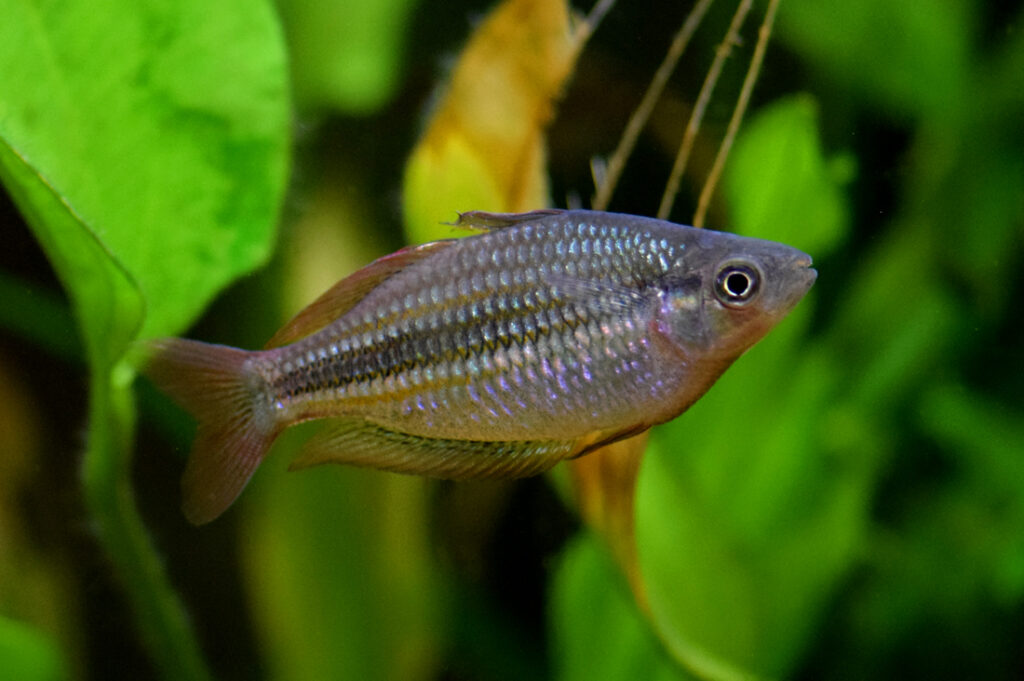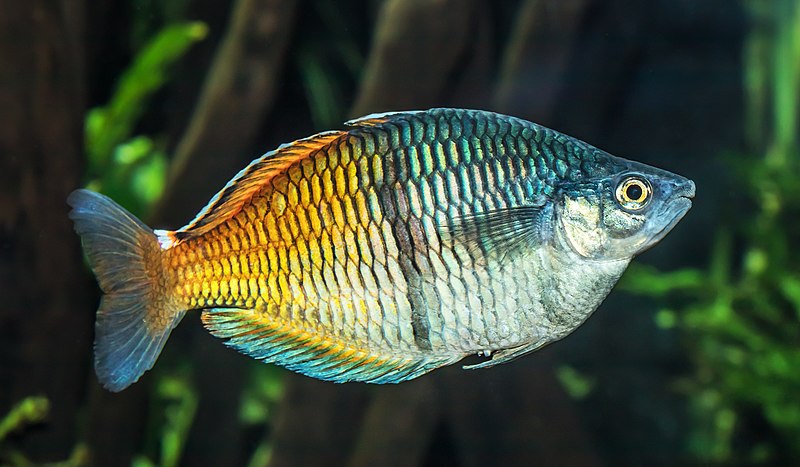The Australian Rainbow fish is a beautiful, multicolored colored fish that is available in a number of different color variations in the aquarium trade. On average, they get between 4 and 6 inches in length depending on the species. It is a schooling fish, so the more members of the school, the more secure the fish will feel and the less aggressive behavior will be exhibited.

This species has been recorded to live up to 6 to 8 years, in the right conditions, in human care. So if you are considering keeping this species, be prepared to have them for a while. In this blog post, you will learn 9 interesting facts about the Australian rainbow fish that will help you to decide if they are the right species for you or not.
1. Where Does The Australian Rainbow Fish Come From?
In the wild, they are found near logs or riverbanks in Australia, New South Wales and Queensland. These habitats are usually slow flowing freshwater rivers, wetlands, billabongs, rivers, drains, creeks, ponds and reservoirs. Here is a look at some Pacific Blue Eye rainbow fish from YouTuber Murky Seb in one of these types of environments:
Some rainbow fish have also been found in the completely opposite environment. Here is one example from YouTuber Murky Seb:
2. Are Australian Rainbow Fish Aggressive?
Most information on these species will tell you that they are not aggressive. However, when I do my research, I prefer to hear straight from someone who keeps a particular species, before I include that information in my blog posts. So with that said, from what I gathered from my research, this species can be aggressive and here are the scenarios that promote such behavior:
- An overstocked aquarium: This species likes to swim and they need a lot of room in order to not feel constricted. If they do feel constricted, they are reported to exhibit aggressive behavior. This behavior ranges from bullying other species to flashing at one another and can even lead to biting and fin nipping. So if your aquarium is overcrowded – regardless of how large it is, an overcrowded aquarium (aside from it not being a good practice) will promote aggressive behavior in your rainbow fish – at the least.
- Having slower swimming fish: These fish are known to be aggressive at feeding time. There are lots of reports from Australian rainbow fish keepers of their rainbows not allowing other fish in the aquarium an opportunity to eat. Their recommendations are to feed the rainbow fish on one side of the tank in order to distract them and feed the other fish on the opposite side of the aquarium. At some point the rainbow fish will get full. Once this happens, the other fish can have an opportunity to eat. As someone who primarily keeps sharks, your best bet in my opinion is to train your fish to feed at a “station”. This helps to reduce aggressive behavior immensely.
- Having a school of less than 6 fish: This issue is reported quite often on the discussion forums from new Australian rainbow fish keepers. The male to female ratio is going to depend on the individual species and on if you are planning on keeping other species of rainbow fish together in the same aquarium. Here is how to tell if an Australian rainbow fish is a male or a female from YouTuber Everyday Aquarist:
In addition to the ratio, the magic number for a school of Australian rainbow fish seems to be 6. Again, please research the specific species that you would like to keep extensively before making a purchase to ensure that you have enough room to house them and to minimize any potential aggressive behavior.
- Some species are more aggressive than others: The Trifasciata Goyder River Rainbow Fish, while absolutely stunning, is known to be an aggressive species.
So be sure to fully and extensively research the species that you are interested in keeping and ensure that they are compatible with the other species that are either currently in your aquarium or that you are planning on keeping with the Australian rainbow fish. Discussion forums with posts from people who have actually kept the species is a great place to start as well as this video collaboration between YouTuber Bentley Pascoe and Blake’s Aquatics:
- Signs of aggression during spawning time: This is most species but yes, the Australian rainbow fish is reported to become more aggressive during spawning time.
3. Are the Australian Rainbow Fish Fin Nippers?
There have been multiple reports of these fish nipping the fins of other tankmates. In addition to fin injuries, there have also been reports of injuries on the bodies of tankmates of the Australian rainbow fish. Avoiding the scenarios that we went over in fact 2 will help to prevent this behavior from occurring.
4. What Are The Best Tankmates for the Australian Rainbow Fish?
Non-aggressive, community, peaceful types of fish are recommended for Australian rainbow fish tankmates. This will vary from species to species. Here are a few examples:

Melanotaeniidae Rainbow Fish
This family of species is known to generally be a peaceful species. They are reported to get along with other species that are similar in size and that are also non-aggressive. Suggested suitable tankmates are:
- Larger tetras
- Peaceful barbs
- Rasboras
- Danios
- Catfish
- Kribensis Cichlids and other non-aggressive species of cichlids
Pseudomugil and Threadfin Rainbow Fish
These species are known to be docile and even sometimes are reported to be shy. With this type of a temperament, suitable tank mates are:
- Small tetras
- Pygmy rasboras
- Peaceful barbs
- Otocinclus catfish
- Corydora catfish
So the best tankmates depend on the species of Australian rainbow fish that you are looking to keep, as well as their temperament and reported compatibility with other specific species.
5. Are Rainbow Fish Top or Bottom Feeders?
Australian rainbow fish are top feeders – and they are known to be absolute pigs! 🙂 The best way to feed them is to train them to go over to a specific section of your tank as their “station” or feeding station, and feed them small amounts of food until they lose interest – which means that they are full. You can do this 2 to 3 times per day in order to keep them fed. This has also been reported to assist in decreasing any aggression due to your rainbow fish feeling like they have to compete for food.
6. Are Rainbow Fish Hardy?
Australian rainbow fish are known to be a very hard species. However, like any other fish, if their water parameters are not well maintained, they can develop diseases like any other fish. Their tolerance to water parameters is reported to be very high, however, it’s best for the animal to keep them stable and favorable. The favorable parameters will depend on the individual species. So be sure to do your research, have the right set up, proper filtration systems and a well balanced diet so that your Australian rainbow fish can absolutely thrive in your care.
7. Australian Rainbow Fish Diet
The Australian rainbow fish is an omnivore, so their diet consists of vegetables, some algae and meats like small invertebrates. A balanced diet with variety is ideal for this species. This comprehensive guide by That Pet Place goes into great detail on how to replicate the natural diet of this species in captivity: Australian Rainbowfish – the Natural Diet of a Popular Freshwater Fish
8. Are Rainbow Fish Jumpers?
Yes and if they feel threatened or get spooked they will jump. While the likelihood of them being jumpers varies from species to species, your best bet is to have a secure lid on your aquarium in order to prevent them from jumping out of your aquarium and hurting themselves or worse – passing away.
9. Are Rainbow Fish Egg Layers or Livebearers?
The Australian rainbow fish is an egg laying species. Not too much is known about their breeding process in the wild, however, there are quite a few aquarium fish breeders who have really dialed in the process in captivity. One of them is YouTuber Jadren Aquatics who created this comprehensive video on rainbow fish breeding which you can watch here:
Let me know in the comments section below which species of Australian rainbow fish that you either currently keep or which species you are researching and thinking about getting.
